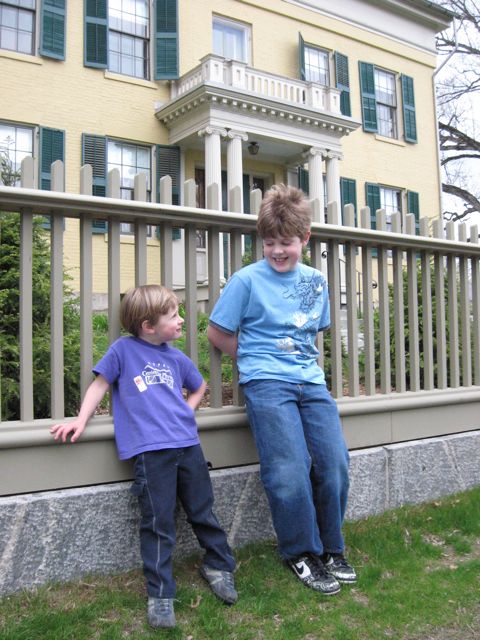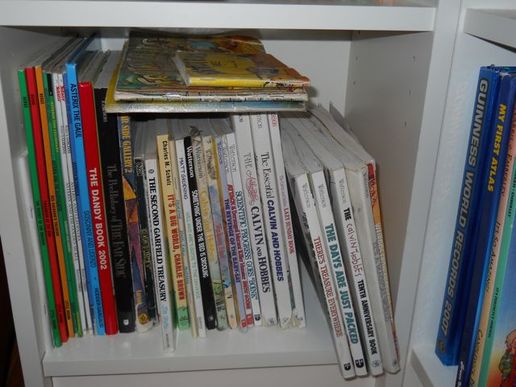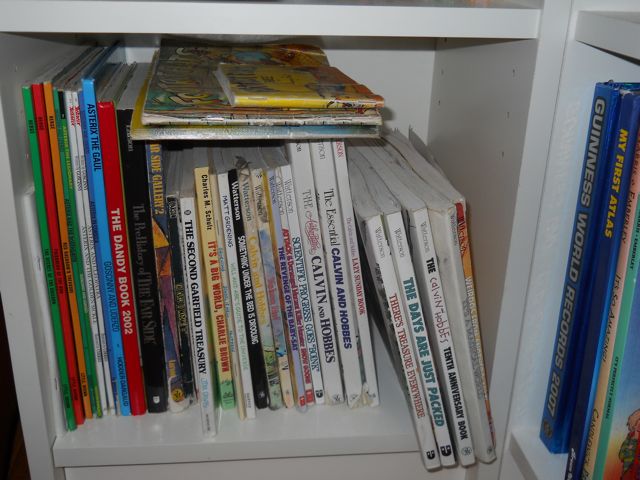I don’t know why this page hasn’t been updated in so long. Obviously some technical glitch in the brain-machine interface, as I’ve been blogging like mad the whole time. You know, the usual chattering stream of perfectly formed consciousness -- limpid, crystalline and deeply musical as it burbles across the jewel-like pebbles in the shallows of my brain, eddying gracefully into fully-formed paragraphs of exceptional intelligence and wit.
I just… keep forgetting to write any of it down.
Bumper sticker version: introverts do it all by themselves. You’re never alone with that inner voice, are you? Except when you realise that none of it was recorded and is therefore all lost down the plughole of history. Oh, the loneliness of the long-distance blogger!
Note to self: write it down.
Especially after spending the last couple of months time-travelling with a couple of top-class oddball 19th C graphomaniacs who shunned and derided company but helplessly, compulsively poured out their infinite thoughts on the page. What they left behind is the next best thing to a Tardis, I tell you.
I will introduce you to the marvellously verbose Victorian New Zealander next time, but first: the spectral madwoman in America’s attic, Emily Dickinson.
--
I’d met the Myth of Amherst briefly in grad school, when a friend helpfully noted that pretty much every poem Emily Dickinson wrote can be sung to the tune of The Yellow Rose of Texas. (That’s one of those earworms that dies outside its host, which is why I had to pass it on without warning you first. Sorry).
I knew a handful of her poems. Not really my thing, but intriguing nonetheless: gloomy flashes of terrifying insight delivered in neat symmetrical lines studded with Capitalised Nouns -- and -- strange -- Punctuation. Form by Hallmark, content by Post Secret. Like Whitman, she sings the body electric, but in Morse Code rather than opera.
I’d agreed to review Lyndall Gordon’s fascinating new book, Lives Like Loaded Guns: Emily Dickinson and her Family’s Feuds, in the hope of learning more about the poet, who after all, is practically a neighbour.
It took me a while to warm up to Gordon's slightly fey prose style, but by the end I couldn’t turn the pages fast enough. Luckily for the author, this story has everything: feisty schoolgirls, psychological warfare, courtroom battles, group sex, late-in-life lust, early death and various degrees of mental instability, plus academic brouhahas and small-town gossip. Also, a medical bombshell, in the form of Gordon’s contentious but well-argued new theory about Emily’s physical ills and her reclusive ways.
As part of my famously comprehensive review process, I skimmed the other biographies and read as much of the poetry as I could manage. Emily, soul-sister! Stranded in small-town New England, conducting most of her business with the world via fierce and zippy correspondence… She'd have been a terrific emailer, and an even better Tweeter.
And then I dragged the family along on an expedition to Amherst, since it’s just an hour up the road from New Haven.
The review should appear in the Listener in the next week or two. For a big book, my review is short, because 600 words is how New Zealand rolls. (Oh, for longer and more challenging book reviews -- hello, new Metro? James Longenbach’s contemplative take in the Nation is a fine example of what you can do with more than a regulation page-with-photo). In the meantime, here's the travelogue version, director's cut.
--
The trick to taking literary field trips with the junior crowd is to make it an over-nighter, and to make sure the cheapo hotel you stay in comes with a swimming pool. We found one on the outskirts of Springfield.
The other trick is food. After working up an appetite in the pool, we took ourselves out to dinner at a quaint local-ish institution called the Red Robin Burger, in a quaint local strip mall, next to a quaint local Barnes and Noble.
Ah, New England. So traditional, so bucolic. The barn-like food barn was full of people mooing contentedly over their industrial-strength (and industrial-quality, and industrial quantity) “food”, and we gladly took our place in the chute. I mean, queue.
We were greeted, cheerfully, by a cheerful worker sporting the company badge that listed the exceedingly cheerful Red Robin code:
Honor
Integrity
Seeking Knowledge
Having Fun!
We were also greeted by a faux verdigris Statue of Liberty, holding aloft a burger haloed in neon, and standing next to a banner advertising the current special… Banzai Burgers.

It’s like Pearl Harbor never happened. We were definitely having fun already!
While waiting for a table, the 8 year old read his book, and the 4 year old waved at people in the nearby booths. The bible study group -- praise the Lord and pass the ketchup -- smiled back. So did a teenager at the next table, but his older companion leaned across, beckoned my boy closer, and growled, with a Cheney-like grimace, “Go away, little boy. I didn’t come here to be your play-date.”
Well, nor he you, Dick; but cheers, anyway.
We left the Roald Dahl character to his conversation, which consisted of boring for New England on the subject of basement waterproofing. I’d have felt bad if we’d been interrupting something special, like an adoption reunion or a father-son sex talk. So I didn’t feel bad. Later, when another customer was treated to the special Red Robin birthday chant with coordinated rhythmic clapping, we considered confiding to the waitress that Mr Grump was turning 100, but alas, he had already gone home to check on his basement situation.
--
The Soul selects her own Society - / then - shuts the Door -
Emily Dickinson, on the other hand, didn’t revile children. Neighbourhood children used to play pirate games in the wooded lot next to her house, and, according to our guide at the Dickinson house, when they stood under Emily’s window calling “Booty, booty!” she would lower baskets of her home-made gingerbread.
She also had a very soft spot for her nephew Gib, who sounds like one of those precocious young wits that you either love or hate. “Dear Santy Clause,” goes one of his surviving letters, “Please bring me whatever you think best. I don’t mean a spanking I mean some common place toys.” Naturally, she loved him.
The houses of famous dead writers are haunted, but artificially so. There are photographs, sample pages of manuscripts, carefully displayed dioramas of their remaining furniture and, usually, a writing desk staged as if the writer has just stepped away for a moment.
The houses of famous dead women writers are doubly artificially haunted, because there’s always a hovering dress in the picture. Like Charlotte Bronte’s impossibly tiny dress at Haworth, Emily’s plain pin-tucked dress, white cotton trimmed discreetly in broderie anglaise, floats in a glass box at the Dickinson house (Charlotte’s is original, Emily’s a reproduction).
It’s as if we can’t grasp these dames except via their frocks. The important thing about Emily’s frock: pockets. A compulsive graphomane, she always had to have pencil and paper on hand to capture her firefly thoughts. Any old paper. Her astonishing poems, diamond-studded nutshells of insight, singular as the flowers she cultivated in her greenhouse, were written on scraps of paper and cardboard, on the backs of shopping lists and letters, in one case on the inside of a chocolate wrapper.
There are 1,775 known poems, mostly written in the 1860s; in 1862 she cranked out at least a poem a day. Only a tiny handful were published in her lifetime; the rest stuffed into drawers, a few given away, some of them bound by the poet or her friend into small booklets.
The Dickinson Homestead was used by Amherst College as faculty housing until 2002, so most trace of the family’s residence there is gone. It’s scrubbed clean, a blank white page, with strategically arranged artifacts in glass cases, a few pieces of furniture, and pictures on the walls. In Emily’s room, the bed is hers but the minuscule desk where she scribbled her poems is a reproduction. The original is safely in a museum at Harvard, which would have horrified her grandfather, who established Amherst College partly as a godly alternative to worldly Harvard.
Emily’s room is not the garret you might imagine, but a four-square and sunny space, with two windows that look down onto the main street of Amherst, and two onto the side yard and across to the Evergreens, the house in which her brother lived with Susan, his wife (and Emily’s friend, constant reader, and perhaps soul-mate). Emily lived in the homestead with her parents and her unmarried sister Lavinia.
Susan threw parties, Austin planted trees, and they raised three children; Emily wrote poems and Lavinia pottered about. All was relatively neighbourly until, in his 50s, Austin tumbled headlong into a passionate affair with a new girl in town, the beguiling Mabel Loomis Todd.
Mabel was a twenty-something faculty wife with city manners, feminist principles, and literary aspirations; also a philandering voyeur of a husband – the astronomy professor at Amherst – and far too much time on her hands. She was eager to broker an acquaintance with the reclusive poet, or failing that, her siblings.
The story of Mabel and Austin’s relationship has been told before, and their steamy letters (including those in which Mabel sweetly wishes Susan would hurry up and die) have been published, but Gordon brings it to life in full Days of Our Lives colour. Part of her task is the rehabilitation of Susan, whose reputation was persuasively and systematically trashed by Mabel in her self-appointed role as Emily Dickinson’s posthumous editor, biographer, and champion.
The astonishing thing is, Mabel never met Emily, who refused any dealings with her. With Lavinia’s knowledge but against Emily’s wishes, Austin and Mabel enjoyed lunchtime assignations in the homestead (also, occasionally, off-site and with other people -- oh, those Victorians!). In particular, they canoodled in the library, which was downstairs and diagonally across from the poet’s bedroom. The homestead is a solidly built house and fairly soundproof, so it’s entirely possible to “entertain” downstairs without disturbing anyone upstairs. But Emily cannot have been unaware, and it seems clear that the Irish maid, Margaret Maher, kept her informed.
(By the way, Aife Murray has written a fascinating book about the Dickinson servants, a nice companion volume to Alison Light's book about Virginia Woolf and her servants).
It is also Margaret we have to thank for the single surviving daguerrotype of Emily, taken when she was seventeen. The family threw it out, thinking it unflattering, but Maggie saved it, without which we’d only know the poet through a childhood portrait. (Another possible image surfaced in 2000 on eBay, but has never been authenticated; the intriguing story is told here).
--
If it’s a truly haunted house you’re looking for, stroll across the yard - as Emily often did, when she was still visiting Susan, before the almost total seclusion of the last ten years of her life -- to the Evergreens.
The Evergreens must have been gorgeous when first built for the newly-wed Austin and Susan: light and airy and decorated in golden wood trim and pale sprigged wallpaper. In 1877, Susan gave the house an Eastlake makeover, transforming it into what we think of when we think of Victorian décor: gloomy, atmospheric, all blood red and dark wood, crowded and cluttered with art and furniture.

Susan died in 1913; her daughter Martha lived there alone till 1923, when she was joined by the young Alfred Hampson as her secretary. After Martha died in 1943, Hampson continued to maintain the house until his death in 1953; his widow Mary lived on in the house till 1988, determined to save it from the terms of Martha’s will, which stipulated that if the house was ever sold, it must be torn down. Fortunately a trust was established, and the Evergreens was eventually folded into the Emily Dickinson Museum.
Restoration is being gingerly undertaken, but as it stands today, the Evergreens is virtually unchanged since Susan presided over the slow death of her marriage in the late 1800s. The interior is sturdy but decrepit: crumbling plaster, torn wallpaper with dark patches where pictures once hung, smoke-blackened ceilings overhead, dangerously frayed rugs underfoot. The piano room where gregarious Susan held parties is crammed with Victoriana. Enormous oil paintings in gilt frames, elaborate sconces, marble statues, heavy dark furniture with clawed feet, a massive mirror over the mantel.
The kitchen, which is in the original 1700s part of the house to which the “new” house was added in 1855, is a revelation. With the original wide wooden floorboards, it is also the only truly modernized part of the house: the black iron Crawford range from 1904 stands next to a gleaming white 1950s stove, and a white cast iron 50s sink with draining board has been installed, adjacent to a cool-room with a slate floor and a dry sink.
Upstairs, you find the servants’ rooms, and the most genuinely haunted part of the experience: the bedroom of Gilbert, known as Gib -- Austin and Susan’s late-in-life child, born when his parents were in their mid-40s.
His homework lies on the desk, his clothes on the bed; the room has stood untouched since October 1883, when Gib died suddenly, from typhoid fever, at the age of 8. His devastated aunt made a rare visit to sit by his sickbed, and thereafter, until her death three years later, she never left the homestead.
(Photography is forbidden, but there are some photos of the Evergreens here, and another visitor describes her experience here).
Poor dead Gib. We were all a bit quiet as we walked back to the main house. I remembered the trip to Mark Twain’s house in Hartford, also a shrine to a dead child, after which our older child, then three, had wailed “I don’t want to die and people put our things into a museum!”
Back at the homestead, I looked for the conservatory Emily’s father had built for her adjacent to the library (I am mad for greenhouses, as was she) but it’s gone, as if it never existed.
The dining room is now a gift shop, where I bought a replica edition of the book Emily’s father gave her mother when they married: The American Frugal Housewife: Dedicated to Those Who are Not Ashamed of Economy (1833), by Mrs Child (Author of "Hobomok," "The Mother's Book," Editor of the "Juvenile Miscellany," &c).
The book has recipes -- including three for gingerbread, which I will try if I can get my hands on some pearlash -- and handy household hints. Never clean your andirons with vinegar. Wash your hair in good New England rum. Huckleberries are just the ticket for constipated children.
On the matter of children, Mrs Child recommends that you put them to good use, starting now:
In this country, we are apt to let children romp away their existence, till they get to be thirteen or fourteen. This is not well. It is not well for the purses and patience of parents; and it has a still worse effect on the morals and habits of the children. Begin early is the great maxim for everything in education. A child of six years old can be made useful; and should be taught to consider every day lost in which some little thing has not been done to assist others.
So we romped in the garden for a bit, piratically, and then the children assisted us to find somewhere good for lunch. A nice Chinese place three blocks away, further than Emily Dickinson walked in all the years she was writing her most enduring poems.

A Thought went up my mind to-day
That I have had before,
But did not finish, -- some way back,
I could not fix the Year,
Nor where it went, nor why it came
The second time to me,
Nor definitely what it was,
Have I the Art to say.
But somewhere in my Soul, I know
I've met the Thing before;
It just reminded me -- 't was all --
And came my way no more.








